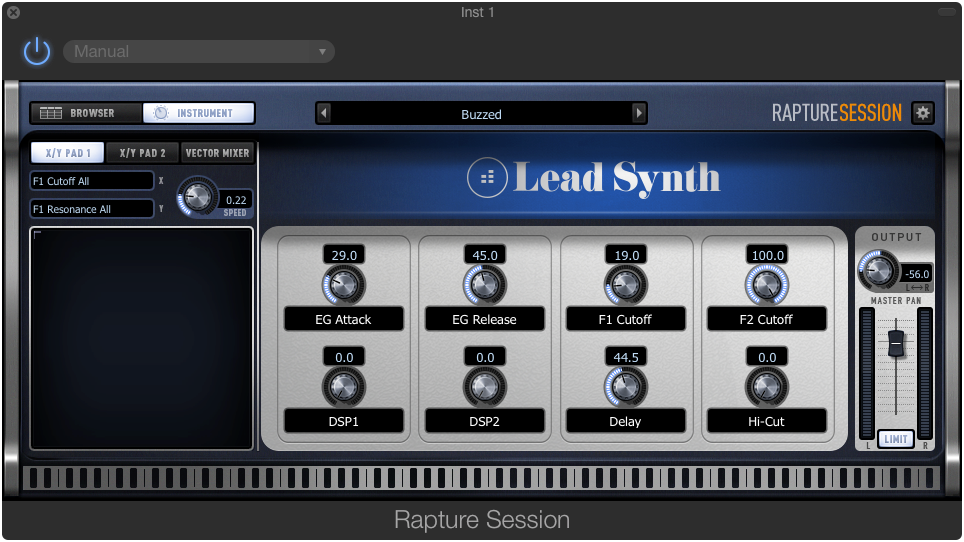Cakewalk Rapture Session REVIEW
PROS: huge library, quality sounds, good search functionality, inexpensive, PC & Mac compatible.
CONS: no standalone version for Mac.
PRICE: $29.99
Cakewalks’s new Rapture Session is a slimmed down version of their fully-loaded Rapture Pro virtual instrument suite. And basically, for those looking to spend a tiny amount of cash for a huge library of sounds, you’re in for a treat. You get tons of synth sounds using the Rapture Pro engine, and hundreds of (usable!) presets to thumb through.
For us, whenever evaluating a soft synth, we have to go to our good-ol’ Moog and Arp sounds as a baseline. So we plugged in our iRig Keys 37 PRO MIDI controller, fired up a few DAWs, and set to work. Rapture Session is available in VST, AU and AAX, so Pro Tools users are now in luck. And of course, as it’s a Cakewalk product, it’s a seamless integration for SONAR.
Since we are using a Mac desktop in our project studio, we tested things out first in Logic and GarageBand, and then Boot Camped it up to launch our sounds in SONAR. Everything was smooth all around, no set up issues at all. In fact, the Cakewalk Command Center makes installation of the software stupid simple, even if you’ve never ventured into the world of software synths before.

Editing made simple in Rapture Session
Getting back to our Moog/Arp tests, we were pleasantly surprised by the sound quality of the available patches across the board. Launching the browser window, you’re given the choice of 11 different categories, anything from standard pianos, lead patches, bass synths (excellent EDM possibilities in there, btw), organs, percussion, etc. For those without a controller, your DAW should allow you to map notes to your keyboard, or use the on-screen keyboard in the Rapture bowser window to start testing tones.
What’s nice is you can also search sounds easily, tag them as favorites for easy recall in the left-hand navigation, and expand things later on if you wish (expansion packs are available, or you can upgrade to the ridiculously feature-rich Rapture Pro if this weren’t enough for you). With almost 5 GB of sounds, though, there’s not a lot missing. And for under $30, we see this as a one-stop solution for producers and guitar players looking to beef up demo tracks and scratch sessions if real instrument equivalents aren’t easily available. Perhaps keyboard enthusiasts would want a more robust solution, but for guys like me, this covers all my bases.
Why deviate from the presets when the presets give you what you need without having to fiddle with parameters? We’re all for tone tweaking and knob-fiddling, but we prefer it in the analog world. Give me a Minimoog and I’m gonna stay up all night twisting knobs and nudging oscillators. But on a computer monitor, sometimes easier is better, and without a tactile sensation we’re usually not into fine-tuning by getting lost in an endless stream of confusing menus. Luckily, editing sounds in Rapture Session is pretty darn easy. Sure, the knobs and faders are digital, but at least their labeling makes sense, and they’re laid out in a way that honing in on your preferred ADSR settings from the analog world is actually intuitive. We’ve seen plenty of virtual instrument packs that claim to have easy editing, and we’re eventually forced to head to a forum somewhere to ask for help. I hate forums, and I hate big-ass PDF guides when things should be self-explanatory and simple to figure out.
After a few weeks with Rapture Session, we were sold. For adding textures and new sonics to your recording projects, it’s a no brainer. We tracked right alongside real instruments through our interface and were able to quickly and easily find the patches we wanted, arm tracks to record our MIDI data, and launch into music-making without the software getting in the way. The Rapture browser will likely be your new best friend for adding bass lines, strings and wailing Rick Wakeman solos, regardless of which DAW you prefer.
Highly recommended.
